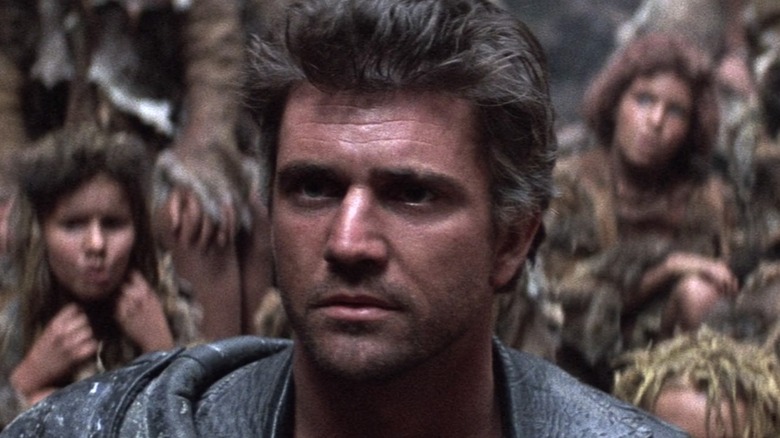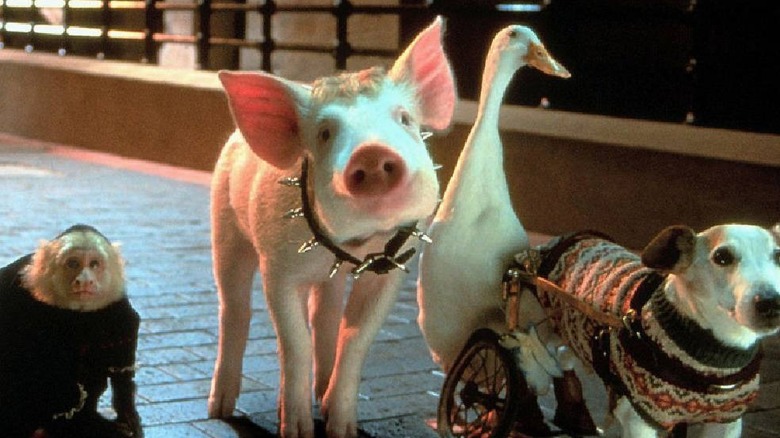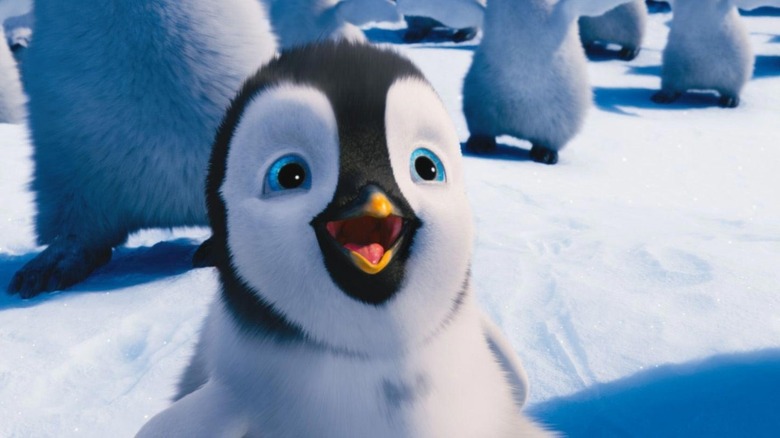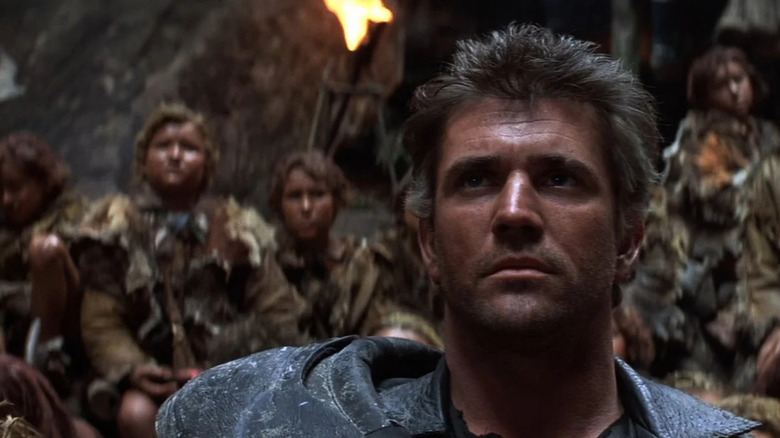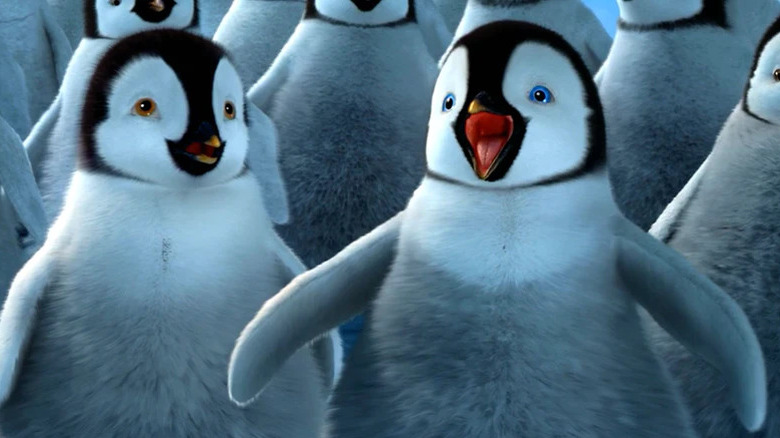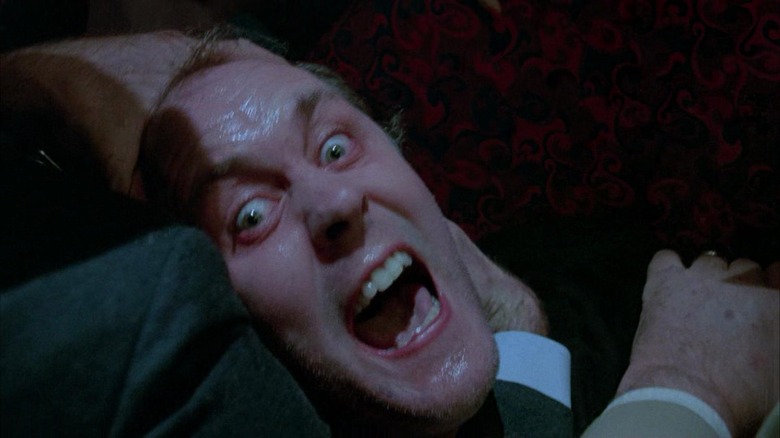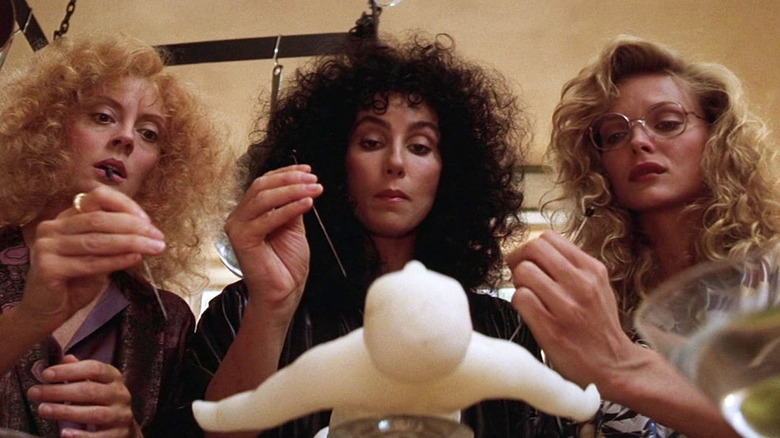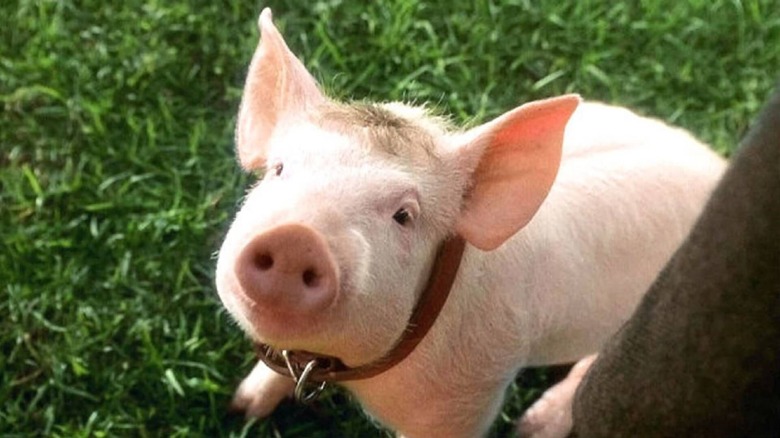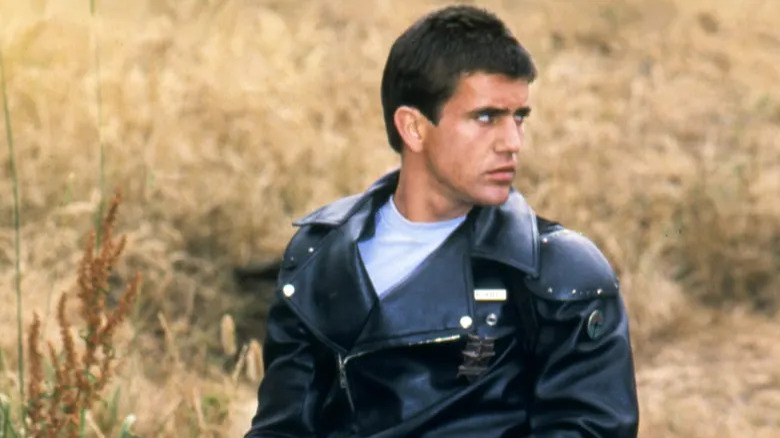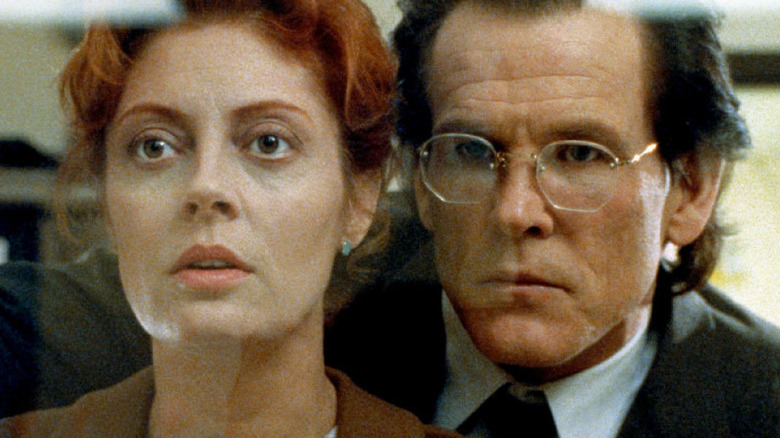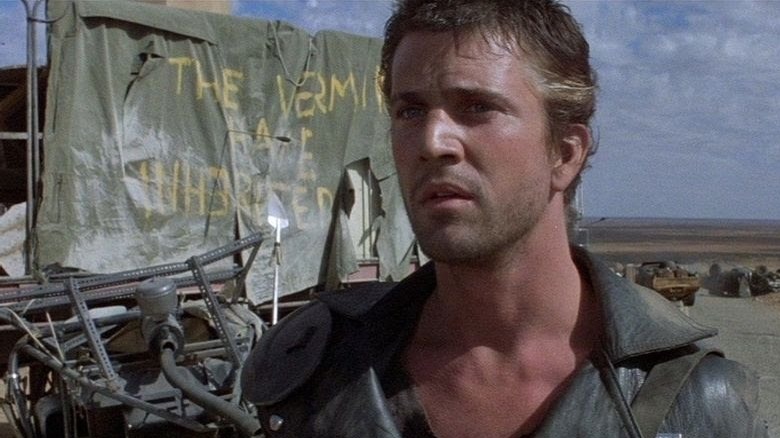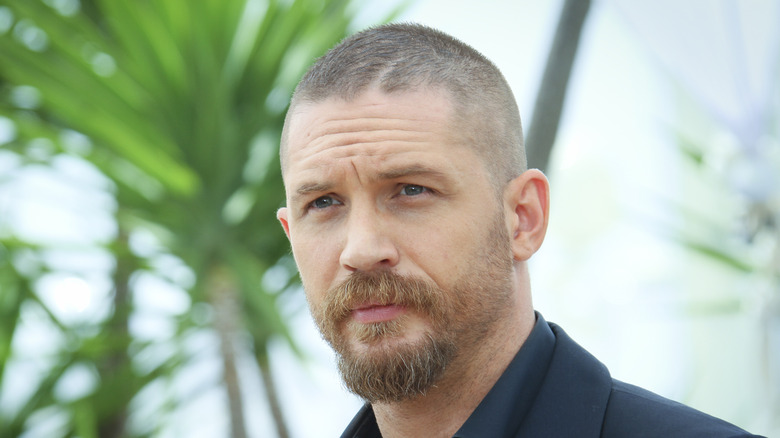Every George Miller Movie Ranked By IMDb
From Guillermo Del Toro and James Cameron, many of today's greatest filmmakers idolize George Miller, the director who burst onto the scene in 1979 with the low-budget "Mad Max." Miller has left his mark with a career spanning a wide variety of films, including everything from over-the-top action movies to children's animated musicals and dramas. Perhaps if he'd stuck to action-adventure flicks like "Mad Max" — or had completed his infamously shelved "Justice League" movie — he might be considered more of a top-tier blockbuster director, but it's his unpredictability that makes him such a unique voice in modern cinema.
During his 40-plus years in filmmaking, Miler has directed just nine movies and written two more, demonstrating his range of genres and styles. The good news is, there's not a bad film in the bunch. If you were to sit down and marathon every entry back to back, you'd go from a delightfully simple, fun little romp right up to one of the best films ever made. The celebrated director has taken several absences from filmmaking, but in 2015 he stepped back into the director's chair for the long-awaited sequel to his beloved franchise. He's now working on a fifth "Mad Max" film — a spinoff that delves into the "Fury Road" hero Furiosa, due in 2022. Where will it end up on the ranking of his best films? While we wait, here's a full ranking of every one of George Miller's big-screen efforts, stacked according to its IMDb score.
Babe: Pig in the City
"Babe: Pig in the City" was co-written and directed by George Miller in 1998. In this follow-up to the surprise hit "Babe" (which had been co-written and produced by Miller and directed by Chris Noonan), the talking pig does what any good sequel protagonist does: head to the big city. While it didn't enjoy quite the critical success as its forebear, it's definitely not a bad movie. The movie is another delightful, family-friendly adventure from Miller, who instills the all-ages story with more life and personality than these kinds of films usually get, and frankly, more than they probably deserve.
"Babe: Pig in the City" was criticized by "The New York Times" for its pessimistic vision of the world, something that was more subtle in the first film, but shone through a little too brightly for their liking. The darker tone was a bit more in line with "Animal Farm" than "Charlotte's Web." While it flopped at the box office, not even able to recoup its $90 million budget, contemporary reviews have been much kinder to the film. Apparently, age has helped highlight its better qualities, with "The Guardian" even going so far as to call it George Miller's masterpiece, and a "grossly underrated sequel." Though not well-loved at its debut, perhaps, 25 years later, this one deserves a second look.
Happy Feet 2
The second disappointing sequel on the list, this one is a follow-up to the 2006 CGI animated musical kids' film, "Happy Feet." George Miller returned to co-write and direct. Several of the superstar voice cast returned from the prior movie, with additions of Matt Damon, Brad Pitt, Common, and others. Tragically, two cast members of the first film had died before the sequel, Brittany Murphy and Steve Irwin, both long before their time. Though it doesn't have the lowest score on IMDb, it is the only one of Miller's full-length films to be awarded a rotten "splat" rating on Rotten Tomatoes, where it sits at 45%.
Still, even Roger Ebert, in his critical review, praised the film's strong musical numbers. David Germain for The Associated Press also gave high marks to Miller's direction. "The sequel delivers the key ingredients that made its predecessor such a hit: lovable characters that audiences young and old will want to follow. A rich blend of pop tunes employed in show-stopping song-and-dance numbers," Germain wrote. It may not win any Academy Awards, but it works as a fun kids' movie, complete with some enjoyable pop songs and adorable dancing penguins. It's a safe bet that families will still have a good time with it.
Mad Max: Beyond Thunderdome
Even after the success of "The Road Warrior," the sequel to his debut "Mad Max," Miller wasn't sold on rushing a third out to theaters, despite the studio's desire for another. "Once I finish one film, there's never any intention to make another one, but then a story comes to you, and that story kind of gets to you ... and that's sort of what happened with the third story, and by the time we got to ['Mad Max: Beyond Thunderdome'] we wanted to push it in a different direction," said Miller, on the process of developing the movie. But by the time filming was ready to commence on the threequel, the director's close friend and producing partner Byron Kennedy had been killed in a tragic helicopter accident. Still grieving, Miller ultimately decided to forge ahead as a way of working through the loss of his friend. He was assisted in his directing duties by his mentor, George Ogilvie.
Even if it is usually marked as fans' least favorite of the original "Mad Max" trilogy, with "The Film Magazine" commenting that it is "lacking the vigor of the [first two] films," most would still agree it's a fun, thrilling adventure, with plenty of entertainment value to be found in the clash between Max and Aunty Entity, ruler of Bartertown (played with gusto by the inimitable Tina Turner). Gibson as Max is as exciting and grounded a hero to root for as ever, and the violence was been amped up even more for its newfound PG-13 rating.
Happy Feet
If George Miller loves anything more than "Mad Max," it might be taking big risks and taking swings at new challenges. He could have stuck with action movies, having been so successful early in his career with them, but he boldly stepped into comedies, then dramas, then family films. His first movie in almost a decade, "Happy Feet" saw Miller once again stretching his filmmaking muscles and tackling another first for himself: an animated musical. Though the "Babe" movies had some special effects, the extensive use of motion capture and CGI was new for Miller. Despite the writer/director's relative inexperience, the result was another triumph for him.
Telling the story of a young penguin's struggle to find his soul mate, it's a typical underdog story, much like his prior efforts on "Babe" and "Babe: Pig in the City," but this time with several toe-tapping musical numbers — all amid dire warnings of climate change. It also featured a star-studded voice cast that included the likes of Elijah Wood, Robin Williams, Brittany Murphy, Hugh Jackman, Nicole Kidman, and Hugo Weaving. In their review, "The New York Times" noted that, although it was a "familiar story about a wee outsider forced to struggle against the usual odds and misguided adults to discover his inner penguin," Miller brought "an unusual depth of feeling to his work as well as a distinct moral worldview." Thanks in no small part to Miller's efforts, the 2006 film won the Academy Award for Best Picture, which remains Miller's only Oscar.
Twilight Zone: The Movie
"Twilight Zone: The Movie" isn't strictly a George Miller film, as it features four distinct segments that update classic episodes of the original "Twilight Zone" television series. That said, George Miller did direct what is probably the most memorable of the four segments, a gripping remake of the episode "Nightmare at 20,000 Feet." Noted film critic Roger Ebert rated each segment separately, so despite his final verdict being mixed on the film as a whole, he gave a big thumbs up to Miller's effort, starring John Lithgow, awarding it three and a half stars, and noting it as the best of the bunch.
In place of William Shatner, who starred in the original, Lithgow gives a strong performance as an airplane passenger who sees a monster on the wing of the plane and struggles to convince those around him of the danger even as he doubts his sanity. Lithgow's appearance was lampooned when he acted alongside Shatner in an episode of his sitcom, "Third Rock From the Sun." Though the movie's reputation and place in film history are marred by the on-set helicopter accident that claimed three lives — including star Vic Morrow and two children (while filming John Landis' segment, a remake of "Quality of Mercy") — its on-screen legacy is bolstered by George Miller's contribution to the film. His reinterpretation of "Nightmare at 20,000 Feet" still stands today as the highlight of the movie for most reviewers, and has become almost as famous as the original episode that it was based on.
The Witches of Eastwick
The only full-length film that George Miller directed without writing himself, "The Witches of Eastwick" built upon the strength of his work on "Mad Max: Beyond Thunderdome," which garnered him a bigger audience with a wider U.S. release. The black comedy marked his first work in the genre and his first feature film without Mel Gibson. Instead of one superstar, he wound up working with four: Susan Sarandon, Cher, Michelle Pfeiffer, and Jack Nicholson.
"The Witches of Eastwick" follows a group of recently single suburban women — two after breakups, one following the untimely death of her husband — who are struggling with loneliness and sexual frustration. Then the devilishly charming (and sexually aggressive) Daryl Van Horne — played perfectly by Jack Nicholson — struts into town. His arrival does more than get the women's libido's stirring; it also awakens the three women's latent supernatural powers. The three aren't just repressed suburban malcontents but also unwittingly powerful witches. Daryl's insatiable lust soon reveals that he, too, is more than meets the eye. The coven's newfound witchcraft and the revelation about Daryl quickly throw their little town into chaos.
The film was a strong outing for Miller, receiving good reviews as a successful dark comedy that skirted the edges of good taste. His efforts produced something rare for the time as well: a sex comedy that was designed primarily to appeal to women. The Hollywood Reporter called it "a perceptive and biting look at Puritanical repression as it affects modern women."
Babe
Critics may have turned their heads when George Miller was announced as the screenwriter of the talking animal film "Babe," based on the 1983 novel "The Sheep-Pig" by Dick King-Smith. Miller had only ever worked on more adult fare to that point, most famously the raucously violent "Mad Max" trilogy, and so writing the screenplay for a G-rated family movie probably seemed like an odd choice.
"Babe," the unexpected hit movie set on a farm of talking animals, told the story of the cute, clever pig named "Babe" who watches wistfully as all his brothers are saved from "Pig Paradise." He wishes he could join them. Instead, "Babe" is saved from the slaughterhouse and brought home by Farmer Hoggett (James Cromwell), where he quickly discovers he has the natural skills of a sheepdog. It's a classic "little engine that could" story, and with all the charm and wit of a Disney feature. Despite the studio supposedly being "appalled" by the final product, it found a fan in Gene Siskel, according to star James Cromwell, who helped bring attention to the fledgling pig picture. "Babe" wound up becoming one of the most beloved films of the year, getting nominated for seven Academy Awards, including Best Picture, with Miller himself even grabbing a nomination for Best Adapted Screenplay.
Mad Max
"Mad Max" wasn't just George Miller's first film; it was a landmark achievement in filmmaking itself, a watershed that shaped more than a decade of science fiction and action movies. It's impossible to understate its influence. Its shoestring budget and stellar critical reception showed studios and budding filmmakers alike that good storytelling and strong direction could make a great film without the expense of films like "Star Wars." In fact, it's not an exaggeration to say that it birthed an entirely new genre of movies, as its success spawned a veritable cottage industry of post-apocalyptic movies set in the desert, with roving bands of leather-clad villains.
Released in Australia in 1979 with its then-unknown star, "Mad Max" arguably had a bigger impact on the career of Mel Gibson than on George Miller. Nevertheless, the revolutionary low-budget flick put Miller on the map not just in Australia but in the U.S. as well. Word of mouth quickly spread. Thanks to a distribution deal with Warner Bros., the film saw release stateside a year later and gained a cult following — despite its English dubbing — for its visceral action and startlingly fresh premise of a lone desert crusader hunting for gasoline. Three sequels followed: two with Mel Gibson, and one belated semi-reboot. What was once a cult classic has since become a premier Hollywood franchise.
Lorenzo's Oil
After "The Witches of Eastwick," George Miller continued his departure from action films, dipping into the tearjerker genre. This time returning to the writer's desk, Miller co-wrote and directed the film "Lorenzo's Oil," a family drama based on the true story of a boy suffering from a devastating degenerative nerve disorder, whose parents who become obsessed with finding a cure. The film reunited Miller with "The Witches of Eastwick" star Susan Sarandon. Nick Nolte and two-time Academy Award-winner Peter Ustinov joined as well. The film illustrated that Miller could do more than make surface-level entertainment like action and comedy films, delivering a heart-wrenching story, as Augusto and Michaela Odone struggle to be taken seriously while finding help for their ailing son.
Though it flopped at the box office and garnered some critiques from the medical community for inaccurately portraying the real-life treatment discovered with the Odones' help as a "miracle cure," the film still impressed critics across the board. Roger Ebert gave the movie four stars, saying "[Lorenzo's Oil] takes a heartbreaking story and pushes it to the limit, showing us the lengths of courage and imagination that people can summon when they must." He also praised Miller, impressed at his ability to elevate the film from what could have become a "disease of the week docudrama."
Mad Max 2: The Road Warrior
Officially titled "Mad Max 2" in Australia, the film was, for most American audiences, the first in the series they'd see, where it was dubbed "The Road Warrior." (That's why you'll often see it referred to as "Mad Max 2: The Road Warrior.") Debuting to applause from critics and audiences, it was praised for its imaginative high fantasy, action-packed plot, and awe-inspiring visuals. It did well at the box office too, particularly considering its relatively small release, low budget, and limited marketing campaign.
The movie continues the post-apocalyptic adventures of the titular Mad Max on his journey across the desolate, post-nuclear war terrain. This time, Max clashes with a gang at an abandoned oil refinery. This gang isn't just some group of random punks, though; they serve film's villain, Lord Humungus, a towering hulk of a man clad in leather and metal who seeks nothing less than total domination of the desert, and to that end is causing problems for the small surviving oil refinery. Max once again becomes involved by defending the refinery, putting him in the antagonist's crosshairs. Like its predecessor, it's a simple tale, but an incredibly effective one that Roger Ebert called "one of the most relentlessly aggressive movies ever made" in his 3.5-star review. Ebert remarked that watching it was an experience he could hardly forget, saying, "the experience is frightening, sometimes disgusting, and (if the truth be told) exhilarating. This is very skillful filmmaking, and 'Mad Max 2' is a movie like no other."
Mad Max: Fury Road
Hailed by many as one of the best films of the 2010s, "Mad Max: Fury Road" was called a "modern American classic" by the New York Times in an exhaustive interview with Miller in 2020 that delved into the long history of the film's development and production. Miller had been pursuing a sequel to 1985's "Beyond Thunderdome" ever since its release. Even after nearly 30 years passed with nothing to show for it, he wasn't ready to say goodbye to his beloved creation. Whether it's considered a sequel, a reboot, or something in between, "Fury Road" delivers one of the most satisfying, intense joyrides a motion picture can, and shows exactly why cinema is such an incredible medium. Essentially one long chase, the film tells the story of an unlikely pair — the titular Max (Tom Hardy), and world-weary revolutionary Furiosa (Charlize Theron) — on a mission to rescue a group of slaves from the villainous Immortan Joe. It all sounds very "Saturday morning cartoon" on the surface, but Miller's powerful direction, combined with the luscious camerawork, breakneck pace, and incredible performances — not to mention a pulse-pounding score — make its case for it being an American classic a solid one.
George Miller's revival of his first franchise was met with universal acclaim. It was one of the best-reviewed films of 2015, being nominated for 10 Academy Awards, including Best Picture and Best Director. It also helped restart the franchise, which is expecting its next entry in 2022, "Furiosa," a prequel to be written and directed by Miller.
